Social Provisioning
Provisioning, in this context, means providing human and ecological needs (like food, shelter, energy, health care, etc) for some community. Social provisioning means to do it with and for all of the members of the community, so that everybody has all they need to live. (Unlike the USA where many people are homeless and starve.)
None of that actually requires money.
I first learned the meaning of social provisioning from Gladys Foster, who, with her husband J. Fagg Foster, were Institutional Economists https://en.wikipedia.org/wiki/Institutional_economics . Institutionalism was a school of economics that was started by Thorstein Veblen https://en.wikipedia.org/wiki/Thorstein_Veblen , among others, who criticized capitalism.
How can social provisioning be accomplished in the real world?
I know of no living examples. Historical examples include https://en.wikipedia.org/wiki/Mandan and several other North American tribes that were matrilineal https://en.wikipedia.org/wiki/Matrilineality , living in large multi-family dwellings built and managed by groups of women.
All of those cultures were killed by capitalist invaders who paved the way for settlers from Europe, who included my ancestors. I was born on Mandan territory.
Here are several proposals for social provisioning systems:
https://docs.google.com/document/d/1NwEcKf-AlD3WlvHFNCmGmDKp9NerPeAaHeTHTrdF628/edit?usp=sharing
The one I like best, called the General Catalog of needs in that overview, has been retracted by its author, although I disagree and still like it.
But none of those proposals has been implemented, as far. This one still seems to be active: https://participatoryeconomy.org/
Ideological positions in the US social-economic system
By ‘ideological position”, I mean “It is not the consciousness of people that determines their being, but, on the contrary, their social being that determines their consciousness.” -Karl Marx (more here: https://www.marxists.org/archive/fromm/works/1961/man/ch03.htm )
I learned this chart of US ideological positions from people in SNCC (the Student Nonviolent Coordinating Committee) https://snccdigital.org/inside-sncc/the-story-of-sncc/
| Position | Gender | Capitalism | Race |
|---|---|---|---|
| Dominant | Male chauvinism | Capital | White chauvinism |
| Subordinate | Subject of sexism | Labor | Subject of racism |
Which of those conditions you were brought up in determines your consciousness. Since you most likely had two parents, you would be affected by the conditions presented to you by each of your parents. Whichever of your parents was the dominant influence on you would also dominantly determine your consciousness. The dominant parent would affect how you approach work, while the subordinate parent would affect how you act socially.
It is possible to change your ideology as determined by your upbringing, but it takes a conscious struggle and would be most effectively done with help with other people trying to make the same changes.
People can react against, as well as conform to, their ideological conditioning; especially in the subordinate poles of those polarities.
And that whole ideological system is shifting in response to current struggles.
The whole current woke-vs-anti-woke struggle is about anti-woke as a reactionary movement of mostly white men feeling left behind by what they call “cancel culture”, as in, they or somebody they know got canceled for their male or white chauvinism (or both).
Next-generation Economic Network Planning and Operations
Short version: this is my vision of how we can meet our resource needs cooperatively in the future.
And here's a relatively quick win: see Economic network software below.
Long version: keep reading.
What it means, how it will work, and the software it will need
An economic network is an organization of economic agents that works together to create and distribute economic resources, for example, a food network composed of farms and food processors and distributors that grows, processes, and distributes food to families. Institutions like schools and hospitals that may also be members of the network.
Older economic networks include commercial supply chains that are also economic networks, but those are dominated by big profit-seeking corporations. The next generation economic networks that we envision will be aimed at provisioning human and ecological needs without private profit and maybe without money.
Why networks?
Big corporations are too big, powerful, rigid, bossy, greedy, etc. Networks can include smaller organizations and even individual people as members, and the participants can form and reform as they like.
Maybe more importantly, capitalist greed will kill the planet. So cooperative economic networks can be an antidote.
My vision requires social provisioning to meet everybody's essential needs. Otherwise people will want corporate or government health care, pensions, etc.
The social provisioning needs to come first. but could be provided by networks for their members and then expand by inter-networking.
Economic network software
Commercial supply chains use a combination of Enterprise Resource Planning (ERP) and Supply Chain Management (SCM) software that typically costs millions of dollars and takes years to deploy. One leading example of such software is https://www.sap.com/index.html
An open source alternative exists, e.g. https://www.odoo.com/ , that greatly reduces the software cost, but not the time and cost to learn and deploy.
But the quick win is to develop a new combo of ERP + SCM based on https://www.valueflo.ws/ – the data models, and most of the logic, are there. And it uses the flow-oriented approach advocated below. And several projects are working in that direction that would love your help. See https://www.valueflo.ws/appendix/usedfor/
Cisco agrees. They filed a patent based on Holochain (one place that Valueflows is being implemented):
Thoughts on the @Cisco patent filing integrating @holochain - as a long-time follower, an active Holo host, and a formerly certified (3x) Cisco associate.
— Todd Youngblood (@todd_x_y) January 16, 2024
Although my certification was in network structure and security, this patent news caught my eye. My initial insight was that… https://t.co/iCfrG6vMW5
The problem with existing ERP + SCM software
Those systems grew by accretion, adding parts year by year, with no overall redesign. The main component was Material Requirements Planning, or MRP https://en.wikipedia.org/wiki/Material_requirements_planning ,
MRP was brilliantly designed: the first business computer system that did something that could not practically be done at scale manually. MRP was flow-oriented. After that, the add-on parts were tacked on from older systems that were not flow-oriented, like Accounts Payable and Receivable that were designed to impede the flows to control the money. Nobody did a redesign of the whole system from flow-oriented principles. And the whole conglomeration of tacked-on parts got bigger and more complicated and expensive and slower to deploy and operate.
Network Requirements Planning (NRP)
NRP is the next generation of economic network planning and operations software. The first version I know of was developed in a collaboration between https://www.sensorica.co/ and http://mikorizal.org/ . Now I'm seeing more people adopt the name and acronym, for example https://www.panorama-consulting.com/network-resource-planning/ .
The NRP system that Sensorica and Mikorizal built was oriented around resource flows. not accounts.
Flow-oriented systems
Resource flows travel in and out and between organizations and even non-human organizations like natural ecosystems:
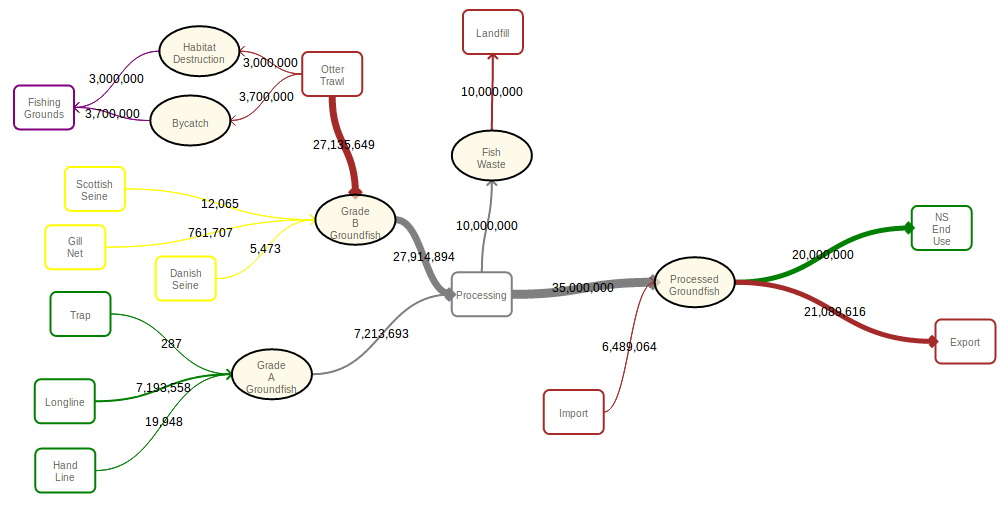 (Alas, that network should compost its fish waste and use it for growing food...)
(Alas, that network should compost its fish waste and use it for growing food...)
The typical ERP system internal data flows are more oriented toward financial controls than material resource flows, so the material resource flows get all chopped up and become difficult to follow, let alone manage.
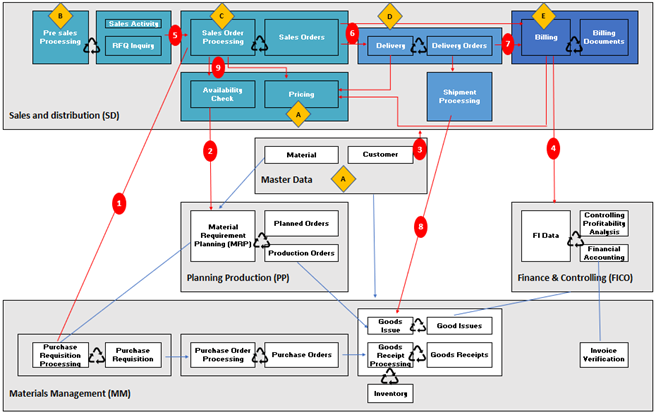
And the internal flows do not connect to the resource flows of other network partners, so a typical ERP system tacks on another whole system to manage supply chains.
In a Network Resource management system, they are all connected as parts of the same flows.
Here's a screenshot from a Valueflows app in development for the New York Textile Lab https://www.newyorktextilelab.com/ :
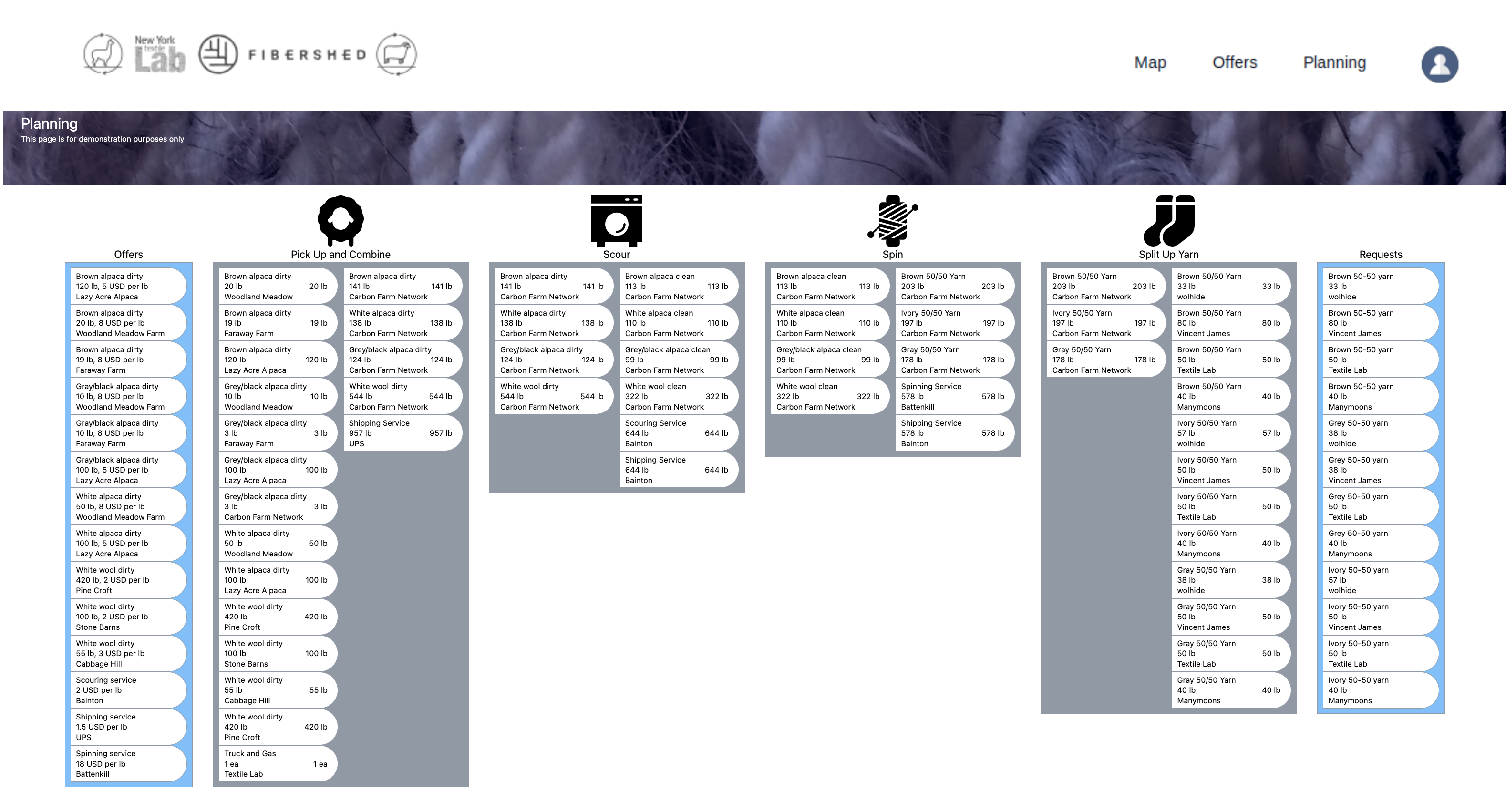
That same table could be used by each of the participants: farmers offering wool, truckers moving the wool to the next stage. scouring mills cleaning the wool, and the table goes on to spinners creating yarn, knitters and weavers making cloth and creating garments for people to wear. And each participant can see what changes each of the other players are making so they can stay in sync. It's very different from an ERP+SCM system that is usually run by the biggest company, usually the head of the supply chain, to manage everybody in the “lower tiers”.
Here are some resource flow diagrams created by the Textile Lab for sweaters, hats, and blankets:
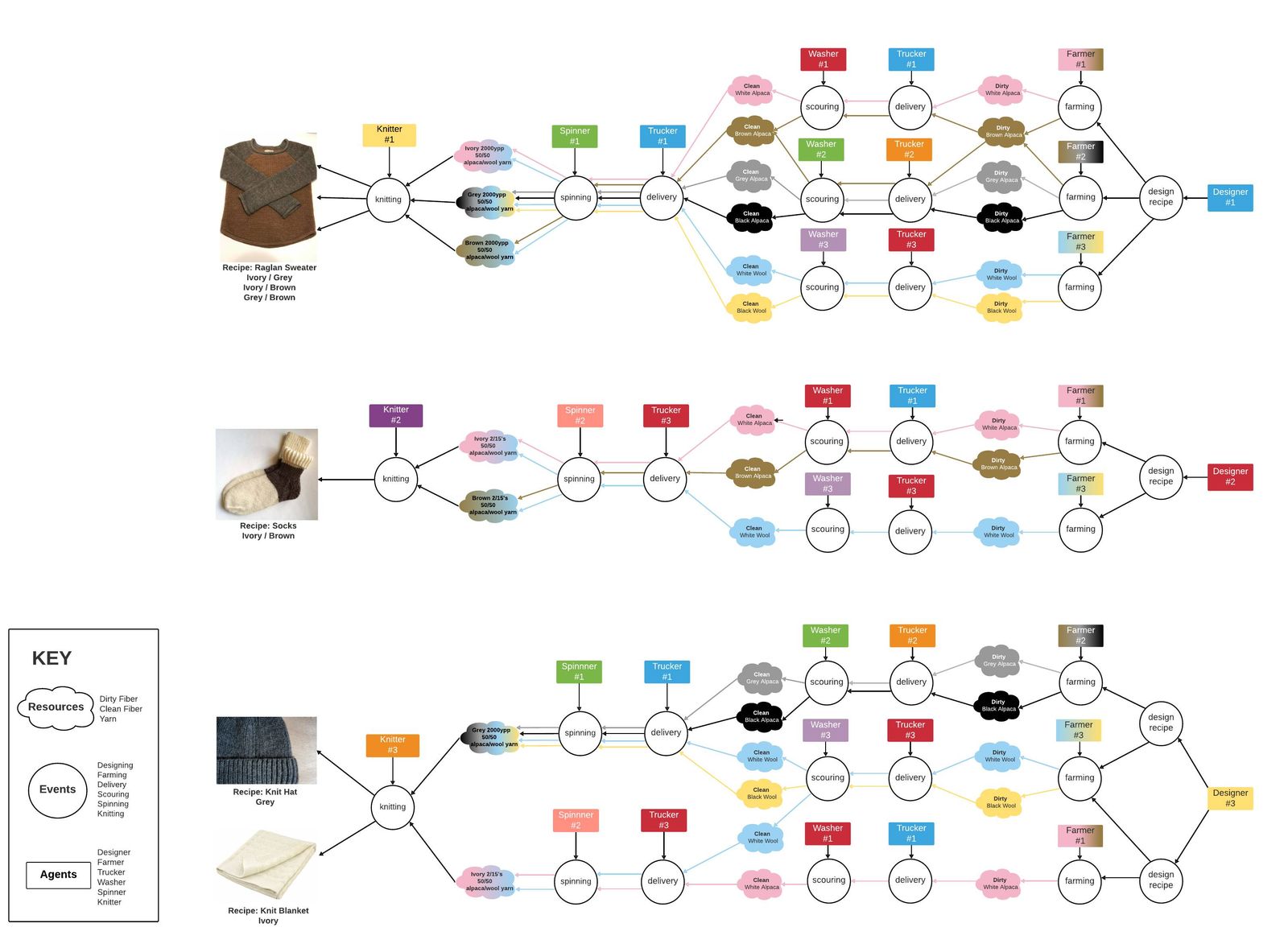
Those diagrams can also be recreated in software. So each of the participants can be contributing to the same diagrams, as with the table above.
Those tables and diagrams are a lot easier to understand and use by the farmers and spinners and weavers in the textile networks than an ERP system. We've done some preliminary tests and will do more and adjust anything that is not quickly understandable.
Once the first example of such a system (the one for the Textile Network) is up and running, similar systems can be tailored for other networks. After the second or third network, the general patterns for economic network software should be identifiable and turned into a software pattern for similar systems.
The bigger wins
- Systems like the one envisioned here can help peer-to-peer cooperative networks manage themselves as efficiently as big corporations are now. Even better, because cooperation will work better for everybody than corporate command-and-control.
- Well-organized economic networks can internetwork, join together, into larger-scale cooperative economies.
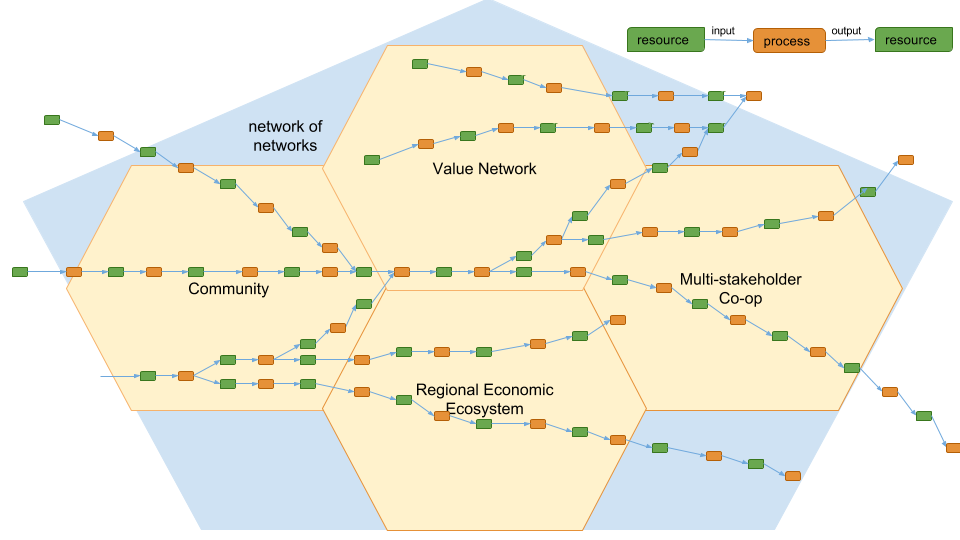
Grain chains as economic networks
We've been seeing grain chains developing in our region, the Driftless Zone. We belong to one grain chain that we met via Meadowlark Organics farm and mill where we get flour for baking. Here's a map of the network they belong to:
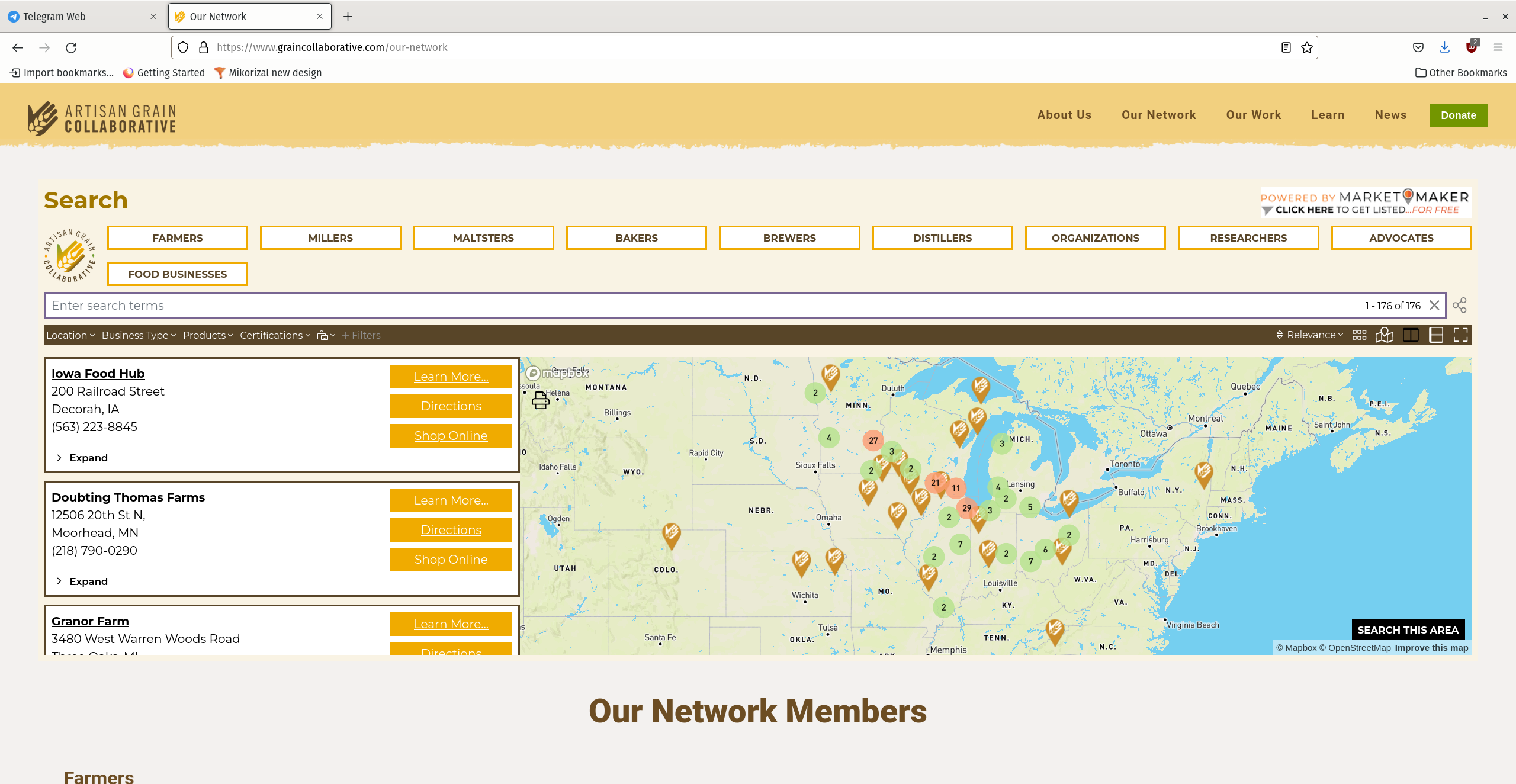 and a link to the network website: https://www.graincollaborative.com/our-network
and a link to the network website: https://www.graincollaborative.com/our-network
And here's The Crumb, a monthly newsletter from Meadowlark's grain chain network.
I just learned yesterday about a software company called GrainChain. We think it is proprietary code so we won't touch it, but it's a sign of the times.
Grain chains are economic networks that organize: * farms that grow the grain, * mills that grind it into flour, * bakers who turn the flour into dough and bake it into bread, * and stores, cafes, and families who serve it to people to eat.
In our case, Meadowlark grows the grain and mills the flour, and told us about the Grain Collaborative network and the Crumb newsletter.
One reason grain chains form into networks rather than the farm selling into open market, the baker buying from and selling to the open market, etc, is that each product in the chain works best when fresh, and each agent in the network wants to have reliable deliveries of high-quality fresh products.
Similar reasons impel other economic networks to form. In many economic sectors, agents (organizations and individuals) tend to deal with known, reliable trading partners rather than open markets. The fabled “invisible hand of the free market” is often a fable rather than a reality.
Flow-oriented systems
Valueflows is a vocabulary and model for creating flow-oriented systems. They are the best design for [economic networks](https://duckduckgo.com/?t=ffab&q=economic+networks&ia=web) like supply chains and economic ecosystems.
The flows in Valueflows create, use, trade, and move economic resources from one EconomicAgent to another, following the Resource-Event-Agent (REA) ISO Accounting and Economic Ontology (need link here but am failing to create links in write.as for now).
Flows evolve from Intents (which means that at least one Agent wants them to happen) to Commitments (which means that two Agents have agreed that this flow should happen) to Economic Events (which means that the flow happened, and the agreed-upon action happened to the designated Economic Resources).
Each flow, at least when it becomes a Commitment, involved two Economic Agents, a provider and a receiver. When the flow becomes an Economic Event, the designated Economic Resources flow from the provider Agent to the receiver Agent.
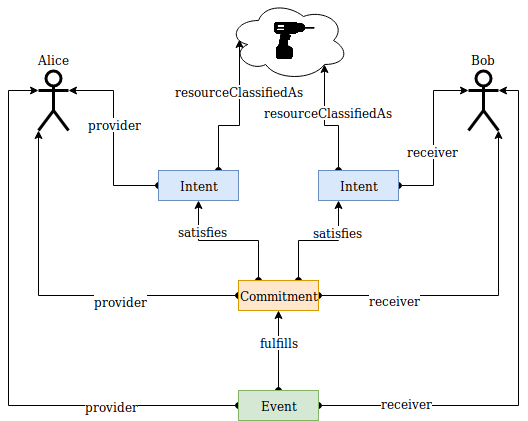
Alice in the diagram may belong to a different organization than Bob, so the flows may travel from one organization to another in an economic network.
So the flows can connect and unify the different organizations in the network and they can all act together to coordinate their economic activities.
Plus, by using the Valueflows vocabulary, each organization can create their own accounting entries for all of their activities in the network.
Flow-oriented systems
<a href=”https://www.valueflo.ws/_”>Valueflows_ is a vocabulary and model for creating flow-oriented systems. They are the best design for ”>Economic Networks like supply chains and economic ecosystems.
The flows in Valueflows create, use, trade, and move economic resources from one EconomicAgent to another, following the Resource-Event-Agent (REA) ISO Accounting and Economic Ontology (need link here but am failing to create links in write.as for now).
Flows evolve from Intents (which means that at least one Agent wants them to happen) to Commitments (which means that two Agents have agreed that this flow should happen) to Economic Events (which means that the flow happened, and the agreed-upon action happened to the designated Economic Resources).
Each flow, at least when it becomes a Commitment, involved two Economic Agents, a provider and a receiver. When the flow becomes an Economic Event, the designated Economic Resources flow from the provider Agent to the receiver Agent.

Alice in the diagram may belong to a different organization than Bob, so the flows may travel from one organization to another in an economic network.
So the flows can connect and unify the different organizations in the network and they can all act together to coordinate their economic activities.
Plus, by using the Valueflows vocabulary, each organization can create their own accounting entries for all of their activities in the network.
Valueflows overview
https://www.valueflo.ws/ describes itself as “a vocabulary for the distributed economic networks of the next economy, to coordinate the creation, distribution, and exchange of economic resources”. This article will focus more on the data models and logic used to “coordinate the creation, distribution, and exchange of economic resources” than the vocabulary used to communicate between economic agents (which is also important).
REA: Resources Events and Agents
Valueflows is based on the REA ontology, which was first defined and published by Professor William McCarthy of Michigan State University in 1982 in this paper https://www.valueflo.ws/linked-docs/REA%2BAccounting%2BModelA%2BGeneralized%2BFramework%2Bfor%2BAccounting%2BSystems%2Bin%2Ba%2BShared%2BData%2BEnvironment1982.pdf .
Bob Haugen, who is writing here, first ran into it in the 1990's when he was hired to lead a project to re-invent ERP (Enterprise Resource Planning) systems. That project was called https://en.wikipedia.org/wiki/Quick_Response_Engine . Existing ERP systems were hodgepodges of older software connected by the software equivalent of spaghetti. The REA model allowed all of the functions of ERP systems to be based on the same simple model and logic. Moreover, ERP systems tacked on a different system to manage their supply chains. But REA can manage both the internal workings of a company plus the whole supply chain using the same simple model and logic. In other words, one system (model and logic) to manage them all, and one system for the players to learn.
The REA data model
- Economic Resources like food, land, tools, work, houses and other buildings, vehicles, energy, etc.
- Economic Agents like people and organizations who manage the Economic Resources, including ecological agents like Lake Erie who influence their ecosystems.
- Relationships between Agents in organizations, like member or employee.
- Economic Events that create, change, and transfer the Economic Resources from one Economic Agent to another.
- Metadata to describe and classify them all:
- Resource Types (which we call Specifications because the word “Type” has too many other conflicting uses).
- Relationships between Resource Specifications like parent and child to define product structures
- Agent Relationship Roles.
- Event Types (Actions).
- Economic Processes which are managed by Economic Agents and which have Input and Output Events, allowing Agents to plan Input-Process-Output resource flows. (Migrating off of metadata.) See https://www.isixsigma.com/dictionary/input-process-output-i-p-o/
- The model has three layers or levels:

REA logic
I will focus here on the logic to plan and coordinate Input-Process-Output resource flows. This logic was first defined by https://en.wikipedia.org/wiki/Material_requirements_planning (MRP) systems. Those were among the first computer-aided systems that allowed people to coordinate processes that would be impossible without the computers.
This logic requires some metamodels defining the relationships among Resources, Events, and Processes. MRP uses Bills of Materials (BOMs) to define the relationships among Resources and Routings to define the resource flows through Processes. We use a combined single model that we call a Recipe https://www.valueflo.ws/concepts/recipes/ that defines the inputs and outputs of Processes and enables IPO flows when the output of one Process becomes the input to another.
Planning IPO flows
Generating dependent demands
You can read a lot about dependent demands here https://duckduckgo.com/?t=ffab&q=dependent+demand&ia=web
Short version: independent demands are externally defined, like customer orders, or internally planned, like “we should do this”. Dependent demands are whatever you need to do to satisfy the independent demands.
To create a plan: start with the independent demands.
Using whatever model you have to define the relationships between Resource Specifications, calculate the quantities and timing of Resources that will be required to satisfy the independent demands.
For each of those Resources, do the same: calculate the quantities and timing of Resources that will be required to satisfy those dependent demands, and keep going, recursively, until all known demands have been added to the plans.
You should end up with trees of planned Resources: a tree for each planned resource: possibly overlapping, becoming a directed graph, or maybe a forest.
Another direction: scheduling forward from output flows.
The previous section was about planning backwards from demands. But it is also useful sometimes to schedule forward from outputs, either known or expected. For example, in agriculture, crops need to be harvested when they are ready, and any subsequent processing of food or fiber needs to schedule forward from there.
The https://www.newyorktextilelab.com/ has animals like sheep or alpacas coming in to be sheared, and textile processing into usable fibers and clothing can't start until the wool comes in to be cleaned.
Combine supply and demand driven planning and scheduling, meet where they make sense:
Once the alpacas come in to be sheared, the wool moves forward into (for example) yarn and socks.
That’s an example of an app based on Valueflows logic, which was designed to coordinate the resources and work of the New York Textile Lab.
Exchanges can also be planned in conjunction with the production or supply chain planning…
…...for example paying a supplier for an input, as the textile lab pays its farmers and service providers for their resources.